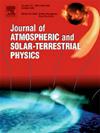A novel hybrid solar radiation forecasting algorithm based on discrete wavelet transform and multivariate machine learning models integrated with clearness index clusters
IF 1.8
4区 地球科学
Q3 GEOCHEMISTRY & GEOPHYSICS
Journal of Atmospheric and Solar-Terrestrial Physics
Pub Date : 2025-02-01
DOI:10.1016/j.jastp.2025.106417
引用次数: 0
Abstract
This study presents an innovative forecasting algorithm that combines multivariate regression (MR) and discrete wavelet transform (DWT) techniques with clearness index (CI)-based clustering methods to enhance short-term (1 h ahead) solar radiation forecasting. The proposed algorithm consists of two main steps: the first involves forecasting processes using DWT and MR methods, while the second includes clustering processes determined based on CI values. In the forecasting process, the data has been decomposed into sub-signals at different levels using DWT first. Multivariate ridge regression (MRR) and lasso regression (MLR) models for the sub-signals have been determined based on input training data sets created from three different combinations of these sub-signals. Sub-forecast signals have been obtained using models that were determined in different formats. The sub-forecast signals obtained have been recombined using the DWT reconstruction to produce the final forecasts. In the clustering process, clusters have been formed based on CI values using the Kernel k-means algorithm, which has been identified as the most effective among three different algorithms. The effectiveness of forecasts generated using DWT-MRR and DWT-MLR models for all input data set versions has been evaluated within the CI-based clusters.
The study's key findings have revealed that decomposition at the first level of DWT is sufficient to achieve optimal forecasting performance. Furthermore, the input variables yielding the best results have differed across clusters: radiation and relative humidity for the mostly cloudy cluster, radiation, temperature, and relative humidity for the cloudy cluster, and radiation and temperature for the slightly cloudy cluster. The results have demonstrated that the proposed algorithm achieves a 17% improvement in root mean square error (RMSE) compared to the best-performing model developed without CI clustering. The proposed approach significantly contributes to the literature by optimizing DWT decomposition levels, adapting data modeling to cloudiness conditions, and integrating multiple forecasting techniques to improve performance.
基于离散小波变换和多变量机器学习模型结合清晰度指数聚类的混合太阳辐射预测算法
本文提出了一种将多元回归(MR)和离散小波变换(DWT)技术与基于清晰度指数(CI)的聚类方法相结合的创新预测算法,以增强短期(提前1小时)太阳辐射预测。提出的算法包括两个主要步骤:第一步涉及使用DWT和MR方法的预测过程,而第二步包括基于CI值确定的聚类过程。在预测过程中,首先利用小波变换将数据分解成不同层次的子信号。子信号的多元脊回归(MRR)和拉索回归(MLR)模型是基于这些子信号的三种不同组合创建的输入训练数据集确定的。使用以不同格式确定的模型获得了分预报信号。得到的子预报信号经DWT重构后重新组合,产生最终预报。在聚类过程中,使用Kernel k-means算法基于CI值形成聚类,该算法被认为是三种不同算法中最有效的。在基于ci的聚类中,对所有输入数据集版本使用DWT-MRR和DWT-MLR模型生成的预测的有效性进行了评估。该研究的主要发现表明,在DWT的第一级分解足以达到最佳的预测性能。此外,产生最佳结果的输入变量在不同的集群中有所不同:多云集群的辐射和相对湿度,多云集群的辐射、温度和相对湿度,以及轻微多云集群的辐射和温度。结果表明,与没有CI聚类的最佳模型相比,所提出的算法在均方根误差(RMSE)方面提高了17%。该方法通过优化DWT分解水平、使数据建模适应云量条件以及集成多种预测技术来提高性能,对文献做出了重大贡献。
本文章由计算机程序翻译,如有差异,请以英文原文为准。
求助全文
约1分钟内获得全文
求助全文
来源期刊

Journal of Atmospheric and Solar-Terrestrial Physics
地学-地球化学与地球物理
CiteScore
4.10
自引率
5.30%
发文量
95
审稿时长
6 months
期刊介绍:
The Journal of Atmospheric and Solar-Terrestrial Physics (JASTP) is an international journal concerned with the inter-disciplinary science of the Earth''s atmospheric and space environment, especially the highly varied and highly variable physical phenomena that occur in this natural laboratory and the processes that couple them.
The journal covers the physical processes operating in the troposphere, stratosphere, mesosphere, thermosphere, ionosphere, magnetosphere, the Sun, interplanetary medium, and heliosphere. Phenomena occurring in other "spheres", solar influences on climate, and supporting laboratory measurements are also considered. The journal deals especially with the coupling between the different regions.
Solar flares, coronal mass ejections, and other energetic events on the Sun create interesting and important perturbations in the near-Earth space environment. The physics of such "space weather" is central to the Journal of Atmospheric and Solar-Terrestrial Physics and the journal welcomes papers that lead in the direction of a predictive understanding of the coupled system. Regarding the upper atmosphere, the subjects of aeronomy, geomagnetism and geoelectricity, auroral phenomena, radio wave propagation, and plasma instabilities, are examples within the broad field of solar-terrestrial physics which emphasise the energy exchange between the solar wind, the magnetospheric and ionospheric plasmas, and the neutral gas. In the lower atmosphere, topics covered range from mesoscale to global scale dynamics, to atmospheric electricity, lightning and its effects, and to anthropogenic changes.
 求助内容:
求助内容: 应助结果提醒方式:
应助结果提醒方式:


